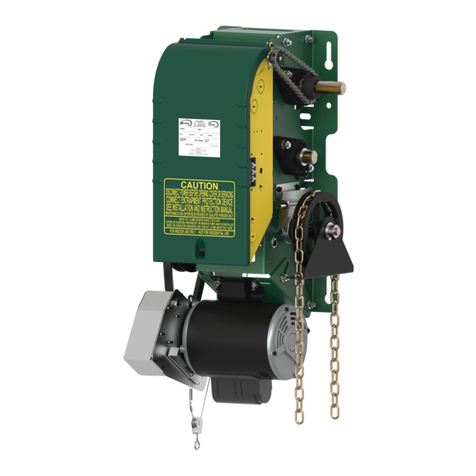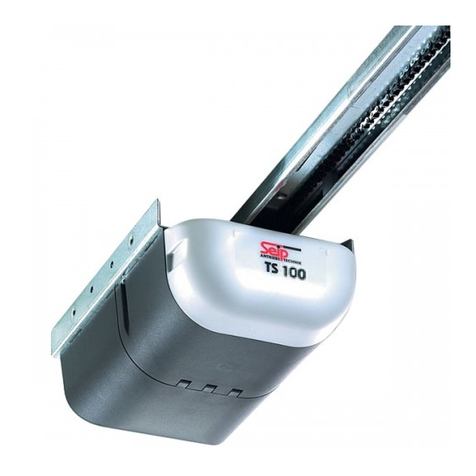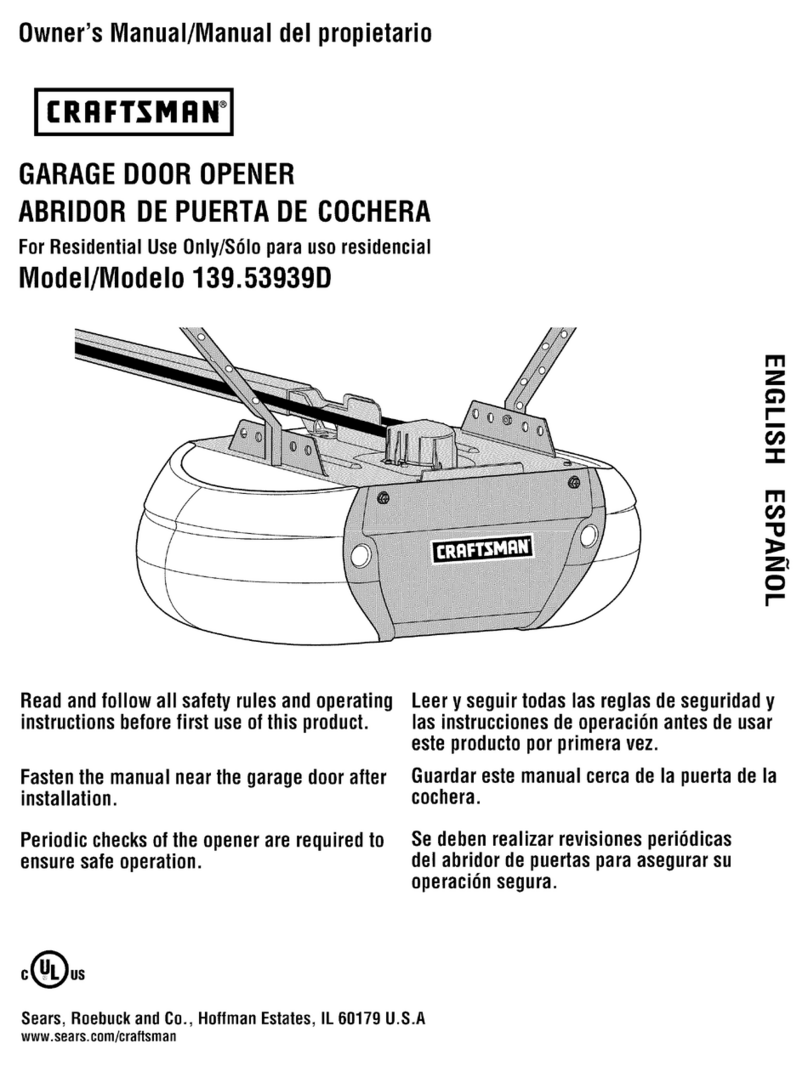Manaras Opera MGT Quick guide

Note:
Read this manual carefully before installing
the operator and place this installation manual in
an accessible place near the operator. For future
reference record:
Model #
Date
Wiring Diagram #
Model #
Project No
Project Name
Door No. #
I
In
ns
st
ta
al
ll
la
at
ti
io
on
n &
&
I
In
ns
st
tr
ru
uc
ct
ti
io
on
n
M
Ma
an
nu
ua
al
l
M
MG
GT
T
®
TM

2
IMPORTANT SAFETY INSTRUCTIONS
WARNING
TO REDUCE THE RISK OF SEVERE INJURY OR DEATH, READ AND FOLLOW ALL INSTRUCTIONS
1. Never allow children to operate or play with or near door.
2. Check to see that the operator is correct for the type, size of door and frequency of use per the operator
specifications.
3. If the door system is near a residential area, or pedestrian traffic is expected near the door system,
additional equipment such as electric reversing edges, photocells, or similar devices must be installed
as part of the system to prevent entrapment.
4. Reversing devices appropriate to the application must be installed as part of the system.
5. Outdoor or easily accessible controls must be of the security type to prevent unauthorized use of the system.
6. Place controls far enough from the door so that a user cannot touch the door when operating the controls.
7. Controls should be placed so the user has full view of the
door when operating.
8. Always keep moving door in sight and away from people or
vehicles until it is completely opened or closed. NO ONE SHOULD CROSS THE PATH OF THE MOVING
DOOR.
9. If a person is trapped under the door, push the "OPEN" control button.
10. Do not overtighten a clutch to compensate for a damaged door.
11. Test door and service monthly. After adjusting the limit travel, retest the door opener. Failure to adjust the
door may cause death or injury.
12. KEEP DOORS PROPERLY BALANCED. See door owner's manual. An improperly balanced door could
cause severe injury. Have a qualified service person make repairs to cables, spring assemblies and other
hardware.
13. If possible, use the emergency release only when the door is closed. Use caution when using this release
with the door open. Weak or broken springs may cause the door to fall rapidly, causing injury or death.
14. You are responsible for assuring that the owner of the door system understands its basic operation and
safety. In particular, be sure the owner/end-user understands the location and operation of the manual
disconnect.
15. Point out to the owner/end-user of the door system that children or pets should not be allowed to play on or
near the door or any part of the system, and that the safety instructions supplied with this operator are the
responsibility of the owner/end-user.
16. Leave the installation and maintenance manual for this operator as well as any additional information
supplied with this operator or other components of the door system with the owner/end-user.
17. If you have any question about the safety of the door operating system, do not install the operator, contact us.
WARNING
DO NOT CONNECT POWER SUPPLY WHILE INSTALLING, SERVICING OR ADJUSTING THE ELECTRIC
OPERATOR
WARNING
NOT APPLICABLE FOR RESIDENTIAL USE. ONLY FOR INDUSTRIAL AND COMMERCIAL APPLICATIONS

3
TABLE OF CONTENTS
Page
GENERAL PARTS & SPECIFICATIONS 4
WEIGHT AND DIMENSIONS 4
PRODUCT APPLICATION 5
DELIVERY OF OPERATOR 5
HARDWARE 5
INSTALLATION 6
CLUCTH ADJUSTMENT 11
BRAKE ADJUSTMENT 11
SCHEDULED MAINTENANCE 13
MGT EXPLODED VIEW 14
SPECIFIC TO ELECTRONIC CONTROL BOARD 15
•Power, Control and Accessory Wiring 16
•Program Setting 20
•Mode Setting 21
•Door Lock Sensor 22
•Troubleshooting on ECB 23-24
•Single phase Wiring Diagram 25
•3-phase Wiring Diagram 26
SINGLE BUTTON RADIO CONTROL & RED & GREEN WARNING LIGHTS 27
•Warning lights sequence 28
•Programming of warning lights sequence 28
•Connection of Red & Green lights 28
SPECIFIC TO HARDWIRED ELECTRIC CONTROL 29
•Wiring of a MGT 30-31
•Accessory wirind diagrams 32-33
•Troubleshooting on hardwiring circuit 36-37
•Single phase Wiring Diagram 38
•3-phase Wiring Diagram 39
WARRANTY POLICY 40
NOTES 41-43

4
SPECIFICATIONS GENERAL
SUPPLY VOLTAGE………………….. 115, 230 VAC single phase 208, 460, 575 VAC three phase
CONTROL VOLTAGE………………. 24VAC class 2 transformer, 2 amp fuse type ACG
MOTOR……………………………… Continuous duty 1/2, 3/4, 1 & 1.5 Horsepower
OPERATOR OUTPUT SPEED……… 103.5 RPM
WEIGHT (net)………………………… 126 lbs (approx), 56.8 kg
STANDARD WIRING TYPE…………… C2 momentary contact to open and stop and constant pressure to close.
DIMENSIONS
(MGT)

5
MGT: THE TROLLEY OPERATOR
IMPORTANT: UPON COMPLETION OF OPERATOR INSTALLATION, THIS MANUAL MUST BE
GIVEN TO THE END-USER
1. PRODUCT APPLICATION
The model MGT heavy-duty trolley operator is designed for use on standard lift overhead sectional garage
doors. All MGT door operators are designed and constructed in accordance with UL and CSA standards.
2. DELIVERY OF OPERATOR
Upon delivery of your heavy-duty trolley operator, inspect the unit immediately for transport damage. Verify that you
have received all the hardware requested with your order (Table 1). Other items may be present, such as radio
controls or other types of optional equipment, if ordered. If any item is missing or if there is evidence of damage, call
the transport company first.
* Check to make sure that the available power supply to be connected to the operator is of the same voltage,
frequency, phase and amperage as indicated on the nameplate of the operator
3. HARDWARE
TABLE 1 STANDARD PARTS LIST FOR MGT TROLLEY OPERATOR
Fi
g
ure 1 Hardware
# Qty Code Description
1 1 STATION020 3 push-button station
2 1 DOORARM001 Door lifting arm assembly
3
4 2
1 TRACKxxx
CHAINxxx Pre-drilled galvanized track
#41Drive Chain Txxx
5
6
7
8
1
1
2
1
BRACKET043
FRONTIDLER007/010
SHAFT017
CARRIAGE006
Front end U-bracket
#41Front idler assembly
Spacer
Carriage
9
10
11
12
13
14
15
6
1
1
1
8
7
1
BOLT026
BOLT031
BOLT035
LINK004
NUT010
WASHER030
NUT022
Hex head bolt 3/8-16UNC x 1-1/4
Hex head bolt 3/8-16UNC x 2-1/4
Take-up bolt 3/8 x 2-1/2
Connecting chain link
Hex nut 3/8-16UNC
Lock washer 3/8
Stop nut 3/8
T2-HBAG

6
4. INSTALLATION
All heavy-duty trolley operators are tested and adjusted at the factory. When installing your unit, please note that the
cams are resting in the center of the camshaft.
4.1 IMPORTANT INSTALLATION INSTRUCTIONS
WARNING
TO REDUCE THE RISK OF SEVERE INJURY OR DEATH, READ AND FOLLOW ALL INSTALLATION
INSTRUCTIONS
1. Installation of this door operator must be done by a qualified installer.
2. Insure that the door is properly installed and works freely in both directions. Do not install the operator until all
door problems have been corrected. If necessary, oil all moving parts (chains, rollers, guides, etc.).
3. Remove all old accessories (locks, bolts, etc.) before installing door operator.
4. Do not connect the operator to a source of power until instructed to do so.
5. Locate control push-button station within sight of the door, at a minimum height of 5 ft. (1.53 m) so small
children cannot reach it, and away from all moving parts of the door.
6. Ensure that the warning tag supplied with the operator is properly fixed on the door and it is visible while the
door is moving. (Figure 2)
Fi
g
ure 2 Warning tag
WARNING
STAND CLEAR OF DOOR AND VERIFY THAT DOORWAY IS CLEAR, THEN PULL EMERGENCY
RELEASE DISCONNECT LEVER TO DISCONNECT OPERATOR FOR MANUAL OPERATION OF DOOR
WARNING
TO PREVENT ENTRAPMENT,
DO NOT START DOOR DOWN UNLESS
DOORWAY IS CLEAR
A
VERTISSEMENT
POUR ÉVITER TOUT COINCEMENT, NE
PAS ABAISSER LA PORTE TANT
QUE L’EMBRASURE N’EST PAS LIBRE.

7
4.2 INSTALLATION OF MGT OPERATOR
IMPORTANT NOTE: THIS OPERATOR MUST BE INSTALLED A MINIMUM OF 8 FT (2.4 m) ABOVE FLOOR
Before the operator is installed, ensure that door has been properly aligned and is working smoothly.
It is advisable to assemble the operator to the trolley tracks on the floor prior to installation.
1. Bolt the tracks to the operator using bolts provided (Figure 3).
Fi
g
ure 3 Assembling operator and tracks
2. Place carriage on rails and slide to forward position, making sure that the chain take-up bolt is facing the
operator (Figure 4).
Fi
g
ure 4 Inserting carriage in tracks
3. Attach front idler and rail spreaders as shown in Figure 5.
Fi
g
ure 5 Front idler and spreaders
4. Attach one end of the chain to the to the carriage using a chain link (Figure 6). Run chain around front idler and
continue around drive sprocket on operator. Then fix second end of the chain using an another chain link to the
take-up bolt and fix the take-up bolt to thee carriage. Chain could then be tightened by adjusting the take-up bolts
in carriage. Properly adjusted chain should sag approximately 2” (5 cm) at halfway point on tracks

8
Fi
g
ure
6
Installing chain
Note: All trolley operators are designed to mount directly over the center of the door, and the operator tracks
should clear the door by approximately 2.5" (6.4 cm). If it is not possible to mount the operator exactly
centered, it is possible to install it slightly off center for torsion spring doors.
5. Establish center line of door by measuring door width and marking a vertical line on the wall directly above the
door.
6. Open the door manually to determine the high arc (highest point) of door travel (see Figure 7). Using a
carpenter's level draw a line so that it will intersect with the vertical line determined earlier.
Fi
g
ure
7
Highest arc of travel
7. The wall mounting bracket has three bolt holes for mounting the front end of the trolley tracks. The bracket
should be attached to the wall with these holes 2.5" (6.4cm) above the high arc of door (Figure 8). Wood blocking
or angle iron framework may be installed on the wall to provide for the attachment of the front bracket.
Fi
g
ure 8 Wall mount bracket
HIGH ARC POINT

9
8. After securing the wall mounting bracket, allow the motor to rest on floor and raise the front end of the rails and
secure (but not tighten) with 5/16” bolts and nuts (Figure 9). If torsion hardware is preventing the rails from lining-
up with the wall bracket, secure temporarily with cord.
Fi
g
ure 9 Installing tracks on wall bracket
9. Hoist rear of operator using block & fall or other suitable means above level of horizontal door tracks and
temporarily secure in place using rope or chain. Tighten front end bracket bolts.
10. Carefully open door by hand and move rear of operator so that it is directly over center of door, with
approximately 3" clearance between door and bottom of operator rails (Figure 10).
Fi
g
ure 10 Adjusting height of operator
11. Hanging brackets may now be affixed from ceiling to operator (Figure 11). Two or more holes are provided in
frame of operator for this purpose. Take care that unit remains centered over door during installation of hangar
brackets. After vertical drops are made and secured, side braces should be installed.
12. Approximately 5 feet (1.5 m) from forward end of rails, locate set of 3/8" holes for angle iron braces to secure
rails. Two drops pieces should be installed at this point to further strengthen installation (Figure 11).
Fi
g
ure 11 Location and installation of hangers and side braces

10
13. Close door. Connect door arm to carriage using 3/8" x 2-1/4" bolt furnished. Fasten door bracket to arm and
position on door as shown in Figure 12. Mount door bracket to center of door in such a way that the door bracket
is also in line with the top rollers on the door.
Fi
g
ure 12 Installing door arm to door
14. Door arm should always lean vertical (Figure 13).
Fi
g
ure 13 Position of door arm

11
4.3 CLUTCH ADJUSTMENT
1. Loosen clutch set screws (Figure 14 A).
2. Back off clutch nut until there is insufficient tension on clutch spring to permit clutch to drive door (Figure 24 B).
3. Tighten clutch nut gradually until there is just enough tension on spring to permit operator to move door smoothly,
but allow clutch to slip if door is obstructed.
4. When clutch is properly adjusted it should be possible to stop door by hand during travel.
5. Be sure to tighten clutch set screws each time operator is tested for clutch adjustment and that it is locked in place
on completion of adjustments.
WARNING
THE FRICTION CLUTCH IS DESIGNED TO PROTECT VEHICLES AND DOOR HARDWARE AGAINST DAMAGE. IT IS
NOT INTENDED TO PROTECT PEOPLE. ALL DOORS SERVING PERSONNEL ARE TO BE FITTED WITH AN
APPROPRIATE REVERSING DEVICE OR REVERSING EDGE TO PREVENT INJURY OR DEATH.
If an automatic reversing device is desired, several types are available as accessories. Consult your dealer for a
recommendation.
Fi
g
ure 1
4
Reducer adjustment
BRAKE ADJUSTMENT
•The brake is factory set. However, after extensive use the brake may need to be adjusted.
•In order to obtain best performance and maximum life, the brake must be adjusted for:
•Proper clearance between the brake band and the brake drum when the solenoid is energized.
•Correct brake tensioning when the solenoid is de-energized.
TO ADJUST THE BRAKE SYSTEM:
1. Remove the solenoid cover.
2. Slightly unscrew the pivot nut (Figure 15)
3. To adjust the brake band tension, move the adjustment lever. To increase tension, move the lever away from
the motor. To decrease tension, move the lever toward the motor
4. Tighten the pivot nut
5. Check clearance but manually holding the solenoid plunger. The brake drum should rotate easily by hand.
6. After adjustment is done, re-install the solenoid cover.
Figure 15 Brake system
Use an appropriate
key to adjust the
clutch
Figure 24 B
Figure 24 A Allen
Key
Reducer
Set screw
&
Clutch nut
Pivot nut
Lever

12
4.4 ADJUSTMENT OF LIMIT SWITCHES
1. Open the cover of the electrical enclosure.
WARNING
NEVER PLACE HANDS OR TOOLS INSIDE OPERATOR OR NEAR DRIVE MECHANISM UNLESS POWER IS OFF
Fi
g
ure 1
6
Adjusting the limit cams
Note: Turning the cam towards the center on the limit shaft increases door travel.
Turning the cam towards the limit switch decreases door travel.
•Open limit switch adjustment:
2. Manually raise the door to a nearly opened position or desired open position.
3. Depress the cams-retaining bracket from the Open side and rotate manually the Open cam (Figure 16)
until the cam activates the limit switches sufficiently so as to hear the switches click (2 clicks for hardwired
circuit. Only one click with ECB and check if the OPEN limit light is ON).
4. Release cam-retaining bracket and make sure that the bracket engages in the slots of both cams.
•Close limit switch adjustment:
5. Manually lower the door to a nearly to 6” above the ground.
6. Depress the cams-retaining bracket from the Close side and rotate manually the Close cam (Figure 16)
until the cam activates the Close limit switch sufficiently so as to hear the switch click (2 clicks for hardwired
circuit. Only one click with ECB and check if the CLOSE limit light is ON).
•Testing door electrically:
7. Upon completion of all wiring connections, use the wall push buttons (or on board buttons for ECB), to run
the door electrically and check if it is stopping properly to fully open and fully close positions.
•Fine adjustment:
If door is not opening or closing properly or if there is a gap between the door and floor, re-adjust the close
limit switch. Note: One (1) on cam is equal to about ½” on the door travel.
For close position: Adjust one notch at a time until the close limit switch is properly adjusted and the door
stop smoothly on closed position.
8. Close the control box once the limit switches are adjusted.
4.5 MINIMUM SUGGESTED WIRE SIZE FOR CONTROL CIRCUIT
The control circuit operates at 24 VAC. Due to the resistance in the wire used to carry the control circuit voltage, it
is important to use the appropriate wire size with respect to the distance between the operator and the push-
button station.
Below is a chart (TABLE 2) indicating the minimum recommended wire size with respect to the total distance
between the operator and the push-button station. DO NOT exceed the maximum distance. If there are
several push-button stations in series you must ADD all these distances before selecting the appropriate wire
gauge for your operator.
If the wire gauge is not suitable for the distance, problems in operation will be encountered such as chattering
relays and contactor, premature wear of the contacts and possible tripping of the motor's thermal protection.
If a greater distance is required, a long distance interface module is suggested (consult factory).
When large gauge wire is used, a separate junction box will be needed for operator power connection (not
supplied).
Rotate cams to
desired position
Press down on
cam retaining plate to
rotate cams
Open Cam
(Open side) Close Cam
(Close side)

13
All power wiring to the operator should be installed by a qualified electrician and may vary with respect to conduit
size and type as specified in the National Electrical Code, Article 430, allowing 5% voltage drop. Power must also
be connected in accordance with local codes.
TABLE 2 WIRE SIZE vs. DISTANCE
24 VAC CONTROL WIRING
Minimum suggested
Wire gauge (AWG) Maximum distance between operator and all
Push-button stations feet (meters)
22 50 (15)
20 100 (30)
18 150 (45)
16 250 (75)
14 350 (105)
12 450 (135)
5. SCHEDULED MAINTENANCE
Inspection and service should be performed anytime a malfunction is observed or suspected.
WARNING
WHEN SERVICING - ALWAYS DISCONNECT OPERATOR FROM POWER SUPPLY
5.1. MECHANICAL
•The door area should always be kept clear of dirt, rocks or any other substance to insure proper operation.
EVERY 3 MONTHS - Check and adjust the brake band and the solenoid, if needed.
- Check and adjust the clutch, if necessary.
- Check all safety features, if responding properly (photocells, pneumatic etc)
EVERY 6 MONTHS
- Check the oil level in the gearbox.
- Lubricate all moving parts, bushings are oil impregnated and are lubricated for life.
- Verify that all mechanical parts function properly.
- Inspect the V-belt and adjust or replace if necessary.
- Manually operate the door. If the door does not open or close freely, correct the
cause of the malfunction.
ONCE A YEAR
- Inspect all bolts and screws and tighten if necessary.
- Check for any excessive slack in chains and adjust or replace them if necessary. The
limit switches may have to be reset after a chain adjustment.
- Inspect the door for wear and damage.
- Run the operator a few cycles:
Make sure that the door rollers are rolling smoothly on the track.
Listen to the motor: The motor should hum quietly and smoothly.
Verify that the limit operates quietly and smoothly: investigate any unusual noise.
- Verify that the mooring bolts are holding the unit securely.
- Inspect the unit for evidence of corrosion.
5.2. ELECTRICAL
WARNING
BEFORE OPENING THE CONTROL BOX COVER, DISCONNECT OPERATOR FROM POWER SUPPLY
•Inspect the wiring compartment and remove any dirt from the control units.
•Verify all the grounding wires and terminations for corrosion. Be particularly careful to check the ground wires.
•Check the terminal strip to insure that all the screws are tight.
•Verify that the security systems installed on the operator are fully operational.
•Verify the voltage at the input terminals while the operator is running. The voltage must not drop more than 10%
momentarily. If the voltage drop is too deep when running, the relays may chatter, the contact points will wear
prematurely and may eventually weld. Verify the power terminations for corrosion.
•Verify the current consumption of the unit with an amp-meter. The value of current should be consistent with the
nameplate specifications. Investigate any anomaly.

14
6. MGT exploded view

15
7
7.
.
S
Sp
pe
ec
ci
if
fi
ic
c
s
se
ec
ct
ti
io
on
n
f
fo
or
r
o
op
pe
er
ra
at
to
or
rs
s
s
su
up
pp
pl
li
ie
ed
d
w
wi
it
th
h
E
EL
LE
EC
CT
TR
RO
ON
NI
IC
C
C
CO
ON
NT
TR
RO
OL
L
B
BO
OA
AR
RD
D
7
7.
.1
1
P
PO
OW
WE
ER
R
A
AN
ND
D
C
CO
ON
NT
TR
RO
OL
L
W
WI
IR
RI
IN
NG
G
D
DI
IA
AG
GR
RA
AM
M
7
7.
.2
2
E
EL
LE
EC
CT
TR
RO
ON
NI
IC
C
C
CI
IR
RC
CU
UI
IT
T
B
BO
OA
AR
RD
D
7
7.
.3
3
P
PR
RO
OG
GR
RA
AM
M
S
SE
ET
TT
TI
IN
NG
G
7
7.
.4
4
M
MO
OD
DE
E
S
SE
ET
TT
TI
IN
NG
G
7
7.
.5
5
C
CO
ON
NN
NE
EC
CT
TI
IO
ON
N
O
OF
F
R
RE
EV
VE
ER
RS
SI
IN
NG
G
E
ED
DG
GE
E
7
7.
.6
6
D
DO
OO
OR
R
I
IN
NT
TE
ER
RL
LO
OC
CK
K
&
&
F
FR
RI
IC
CT
TI
IO
ON
N
C
CL
LU
UT
TC
CH
H
7
7.
.9
9
T
TR
RO
OU
UB
BL
LE
ES
SH
HO
OO
OT
TI
IN
NG
G
G
GU
UI
ID
DE
E
N
NO
OT
TE
E:
:
P
Pl
le
ea
as
se
e
r
re
ef
fe
er
r
t
to
o
p
pa
ag
ge
e
2
27
7
f
fo
or
r
h
ha
ar
rd
dw
wi
ir
re
ed
d
o
op
pe
er
ra
at
to
or
rs
s.
.

16
Before installing power and control wiring, be sure to follow
all specifications described below. Failure to do so may damage
the operator.
•The operator must be properly grounded and connected in
accordance to local electrical codes.
•Use different knockouts available on EACH side of the control box to
pass the power and control wiring through.
•Ensure maximum separation between power wiring and low
voltage control wirings in the control box.
•Please refer to next page for details.
•If a push button is not used, a jumper
must be placed between #8 & #9
***Under this condition a stop command is
not available to stop the door during its
travel.
•Please refer to Accessories Wiring
diagrams (TN005E) before connecting
any external accessories
•2 Amp fuse is used to protect 24VDC
on electronic board and also the 24VAC
supply for auxiliary control devices
7.1 POWER AND CONTROL WIRING DIAGRAM
VERY IMPORTANT NOTES

17
STATION031AIRSWITCH007
Open
Close
Stop
Red Yellow
8
7
NONC
NONC
NONC
9
Adjustment
3 5 6
KEYSWITCH019
6 7 8 9
KEYSWITCH015
Jumper must
be removed if
a station with
a stop button
is also
connected
67 8 9
Route the power
line wires either
from right of the
control box.
Route all low
voltage control
wires as shown.
Keep low voltage
wires separate
from line voltage
wires.
LOW VOLTAGE (controls) AND HIGH VOLTAGE (power) WIRINGS.
Accessory Wiring
WARNING
•Wall control(s) must be located so
that the door is within sight of the
user.
•If momentary contact (B2 mode) is
used, an external reversing device
must be install.

18
L
3
N
/
L2
L/L1
AIRSWITCH009 STATION020
PULLCORD003
Open/Close
Open Only 73
43
115/208/230 VAC
1 Ph. 60 Hz
208/230/
460/575 VAC
3 Ph. 60 Hz
24VAC (10VA MAX.) ONLY FOR THE
SUPPLY OF PHOTOCELLS, LOOP
DETECTORS, KEYPADS…
21 4
Power Suppl
y
White
Green
3 5 6 7 8 9
Circuit
5V DC
3
5
2-wire Electric Sensing Edges
White
Brown
Blue
Oran
g
e
5
2
1
3
PHOTO051
1 2 5
3
1 3 22 15
PHOTO008
3 5
2
Black & white
White
Black & white
White
1
Interface Module Jumper
(TK8200)
Always set the jumper
located inside the
Interface Module on
N.O (Normally Open)
NOTE
PHOTO044

19
7.2 ELECTRONIC CONTROL BOARD
LED MONITORING STATUS
LED’s on the ECB help will wiring and making troubleshooting diagnoses. Every LED states the actual position of
the door. The board has a non-volatile memory and all the LED return to their initial state after a power
interruption.
Stop LED OFF:
•Check if the Stop button is properly connected on #8 and #9 or if a Normally Closed contact is used.
•Verify if the Hoist is properly engaged and if the Hoist switch is closed (or if any external interlock device is
remained open)
EXTERNAL CONTROLS
Refer to the wiring diagram on page 16 before connecting power or any external device to the ECB. Neglecting
to use the proper terminals will result in complete damage to the ECB. If you are not certain about procedures,
please consult Manaras for assistance.
NOTE: Do not attempt correction by reversing wires on control station.
L.E.D Color Status
+24 V Green When ON indicates the presence of 24VDC on the Logic Board
+5 V Green When ON indicates the presence of 5VDC power in the Control Circuit
Open Limit Red When ON indicates door position, completely open.
Open Red Only when the open relay is activated (open relay is energized)
Close Limit Red When ON indicates door position, completely close.
Close Red Only when the close relay is activated (close relay is energized)
Safe Red Light ON only when safety devices are activated.
INDICATOR Red
Flashes only when motor runs in opposite direction and activates the
wrong limit switch.
Stay ON only when the “centrifugal switch” is opened (please contact
technical support)
STOP Yellow In normal conditions light; stay ON, goes OFF every time when press
STOP button or hoist is engaged
WARNING
WHEN REPLACING AN ELECTRONIC CONTROL BOARD DO CHECK THAT ALL JUMPERS ARE
POSITIONED AS INDICATED IN THE WIRING DIAGRAMS ON PAGE 23 FOR SINGLE PHASE AND
ON PAGE 24 FOR 3-PHASE.

20
•Program and Program settings
Programming ability and door control at electrical box are provided by Open/Close/Stop buttons and Rotary Switch
located on the ECB.
•Programs
7.3 Program setting
Door should be in fully closed position while setting of these following programs.
PROGRAMS FUNCTIONS AND DESCRIPTIONS
RUN TIMER The Run Timer stops automatically the operator after an adjustable time delay either travelling
upwards or downwards. The Run Timer is designed to protect the door and the operator by preventing
the motor over running much longer than the normal time.
MID-STOP
Mid-Stop function will, when active, move the door from the down position to a predetermined Mid-stop
position when the open button or Open/Close device is activated. Once at Mid-Stop, subsequent
Open/close commands will close the door. To move the door to full open position, the open button
must be pressed again.
TIMER TO CLOSE Timer to Close is a function that, when active, will close the door after an adjustable time delay once
the door has reached its fully open and mid-stop position. The timer to close function works only in T
and TS modes.
TIMER TO CLOSE (from
fully open position only) Option used in conjunction with MID STOP function. When activated, Timer to Close is active from the
fully open position only and not from the mid-stop position.
ADVANCE CLOSED
TIME
“Advance close limit switch” is not needed with this feature. Advance close time will disable the
reversing device once the close limit switch is activated and will stop the door after 200 milliseconds
before it reaches the fully closed position.
Note: Door distance traveled within these 200 milliseconds may vary depending on the door speed.
PROGRAM SETTING
PROGRAMS ACTIVATE DEACTIVATE SELECT
SWITCH
RUN TIMER
•Check if close limit switch is activated.
•Set select switch on D.
•Press “Open” button to add 10 sec to the
total time needed to open the door.
•Set the select switch on run mode (0, 1, 2, 3,
4 or 5).
•Set select switch on D.
•Press “Stop” button.
•Set the select switch on run mode (0, 1, 2,
3, 4 or 5).
MID-STOP
•Check if the close limit is activated.
•Set select switch on “C”
•Press “Open” button then press “Stop”
button on desired Mid-Stop position.
•Set the select switch back on run mode (0,
1, 4 or 5).
•Set select switch on “C”.
•Press “Stop”, “Close” and “Open” buttons
consecutively.
•Set the select switch back on run mode (0,
1, 4 or 5).
TIMER TO
CLOSE
•Set select switch on “B”.
•Press “Open” button to add 15 sec or
“Close” button to add 1 sec each time (max.
4 minutes & 15 seconds).
•Set the select switch on T or TS mode.
•Set select switch on “B”.
•Press “Stop” button the timer to close is
reset to 0 sec but still activated.
•To deactivate the timer to close
completely set the switch on desired
position (0, 1, 2 or 3).
TIMER TO
CLOSE
(from fully open
position only)
•Set select switch on ”6”.
•First press the “Close” button and then the
“Stop” button.
•Set the select switch on T or TS mode.
•Set select switch on “6”.
•Press “Close” button.
•Set the select switch on T or TS mode.
*Now the Timer to Close works from fully
Open and Mid-Stop positions.
Controlling Timer to Close from floor level (using wall buttons)
While door is in closed position, by pressing “Stop” 3 times and
“Close” 3 times consecutively on the push button station, the timer
to close is deactivated (timer to close is suspended).
Timer to close is re-activated (timer to close is back to
normal function) simply when door is closed either from
fully open or from mid-stop positions.
8
9
D
B
A
C
E
F
0
7
2
6
5
3
4
1
D
C
B
A
9
8
F
E
0
3
6
5
7
4
2
1
D
A
B
C
9
8
F
E
0
4
6
5
7
2
1
3
0
F
D
B
C
A
9
8
E
1
6
7
5
2
4
3
Table of contents
Other Manaras Garage Door Opener manuals
Popular Garage Door Opener manuals by other brands
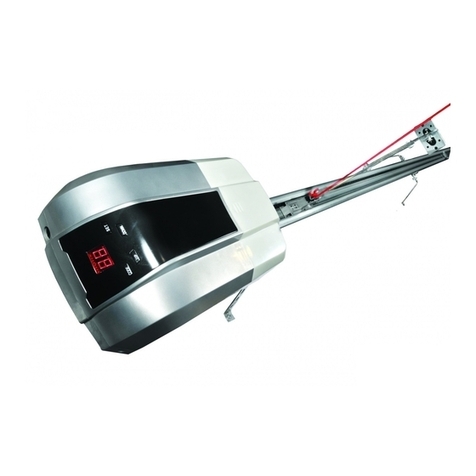
AN-Motors
AN-Motors ASG/KIT Series Installation and operation manual
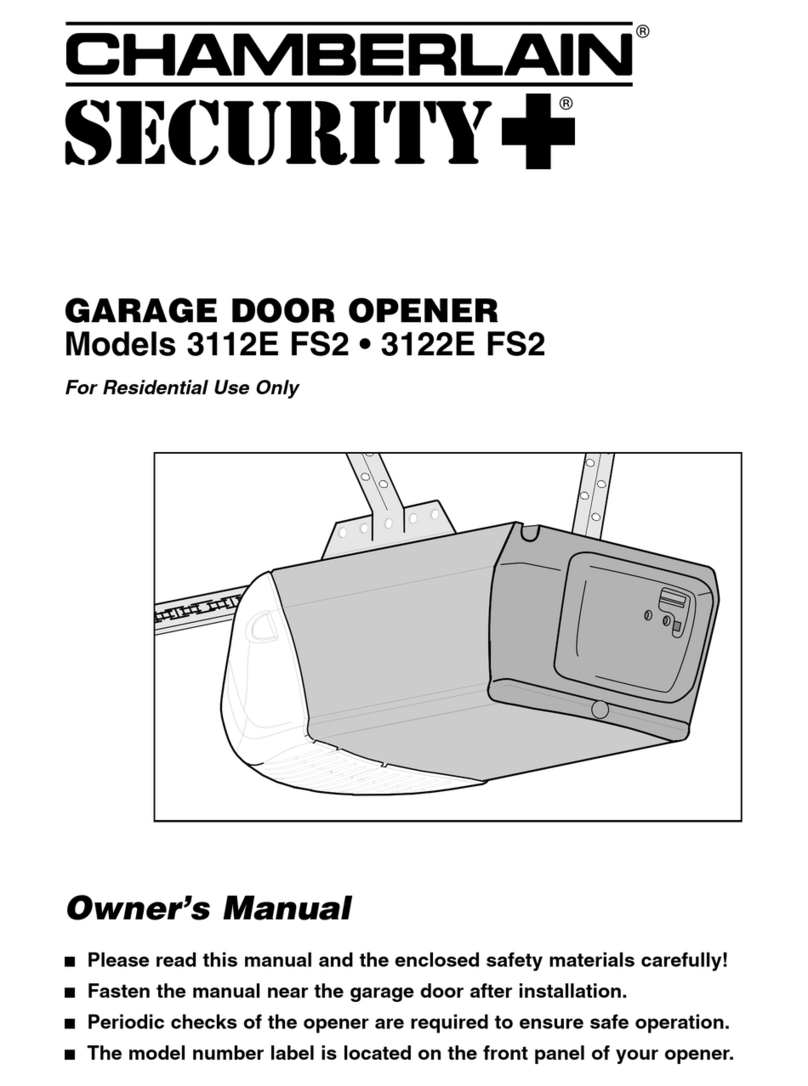
Chamberlain
Chamberlain Security+ 3112E FS2 owner's manual
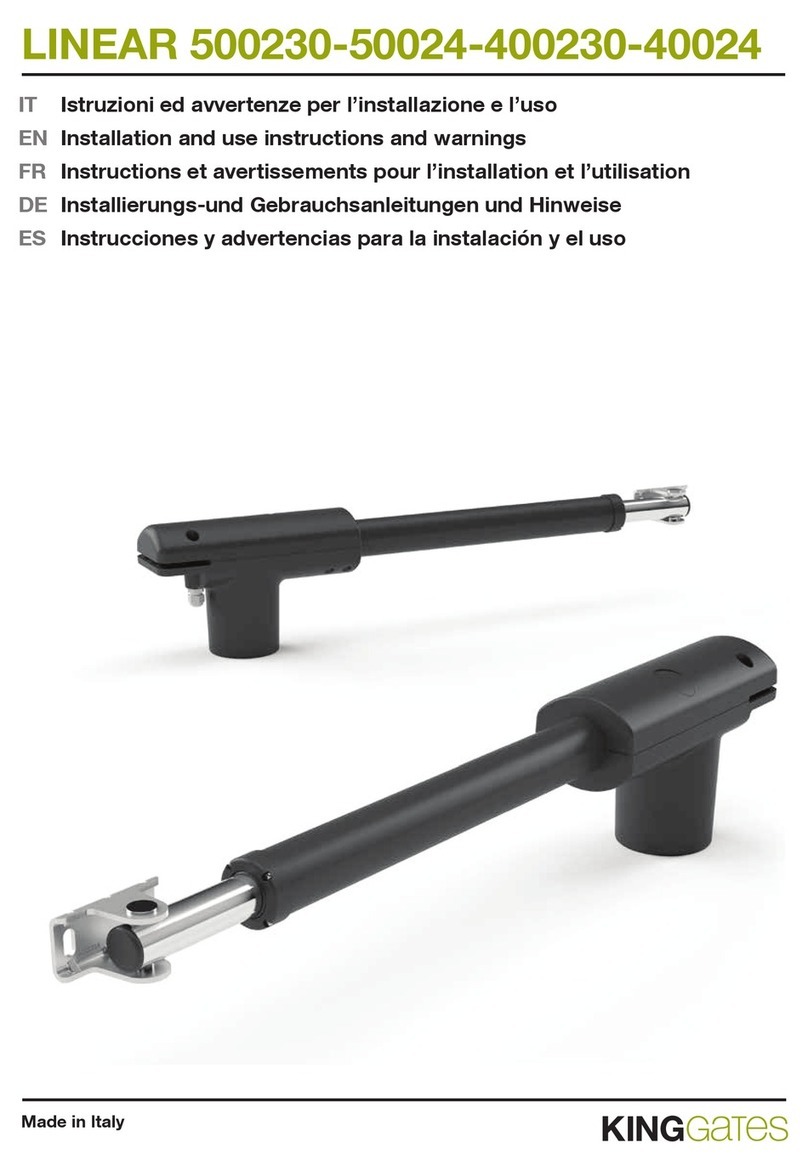
King gates
King gates LINEAR 500230 Installation and use instructions and warnings
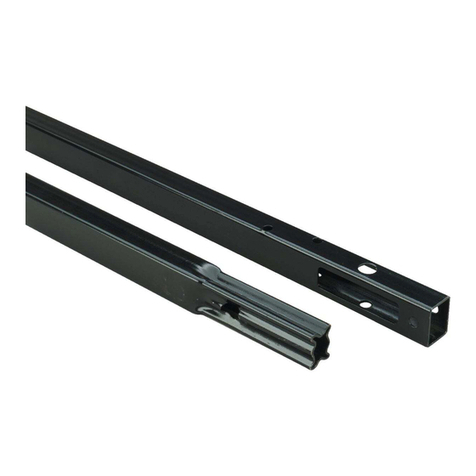
Chamberlain
Chamberlain 8808CB quick start guide

Bame
Bame TIGER 230 V Installer manual

DACE
DACE LUX DC12 Installation & user manual
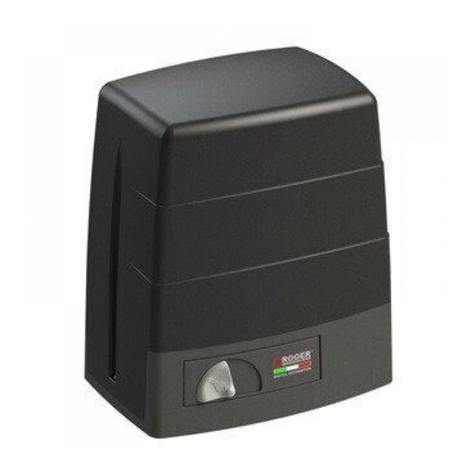
Roger Technology
Roger Technology BM30 Series INSTRUCTIONS AND RECOMMENDATIONS FOR THE INSTALLER

Genie
Genie GCL-GT Specifications

Craftsman
Craftsman 32LB580B owner's manual
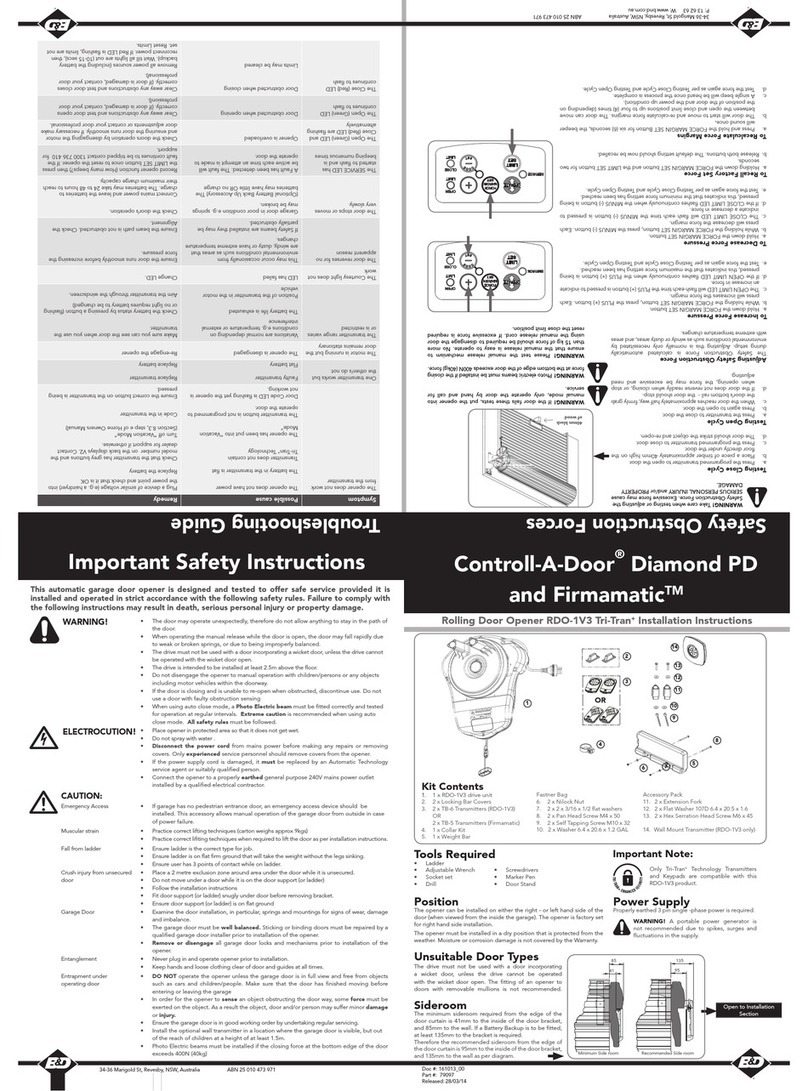
Controll-A-Door
Controll-A-Door RDO-1V3 installation instructions
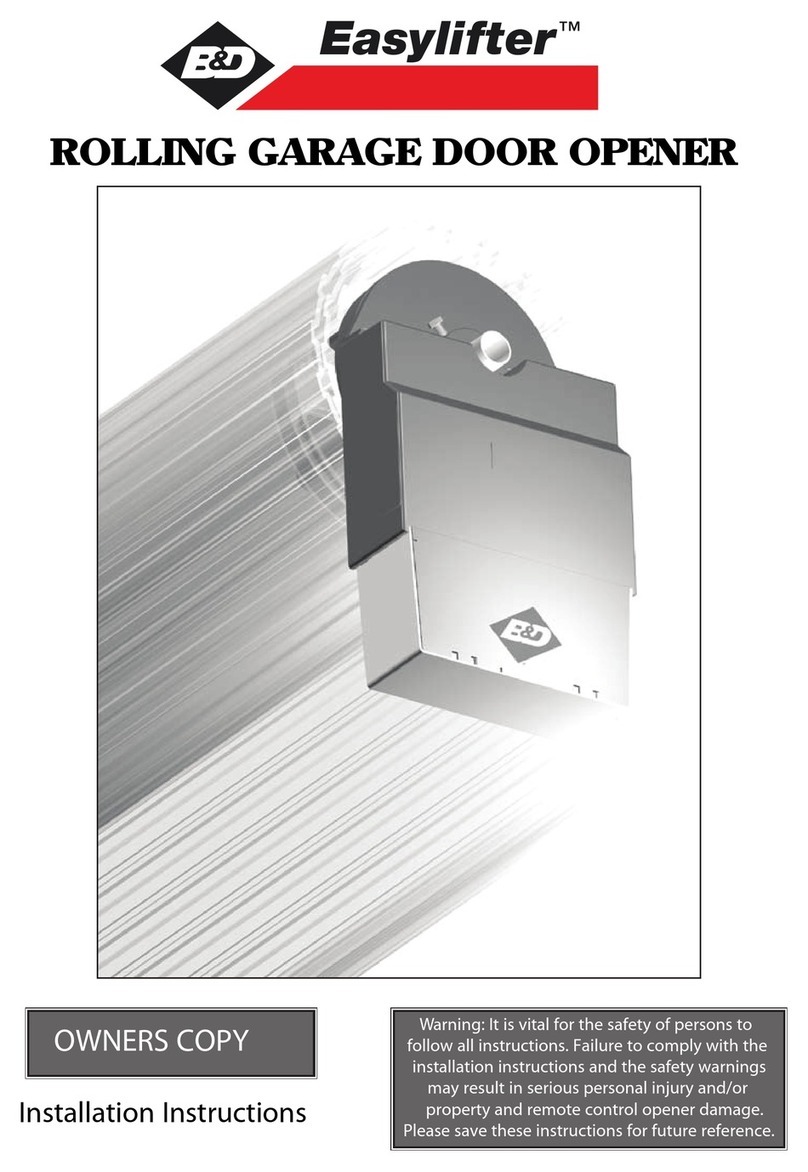
B&D
B&D Easylifter installation instructions
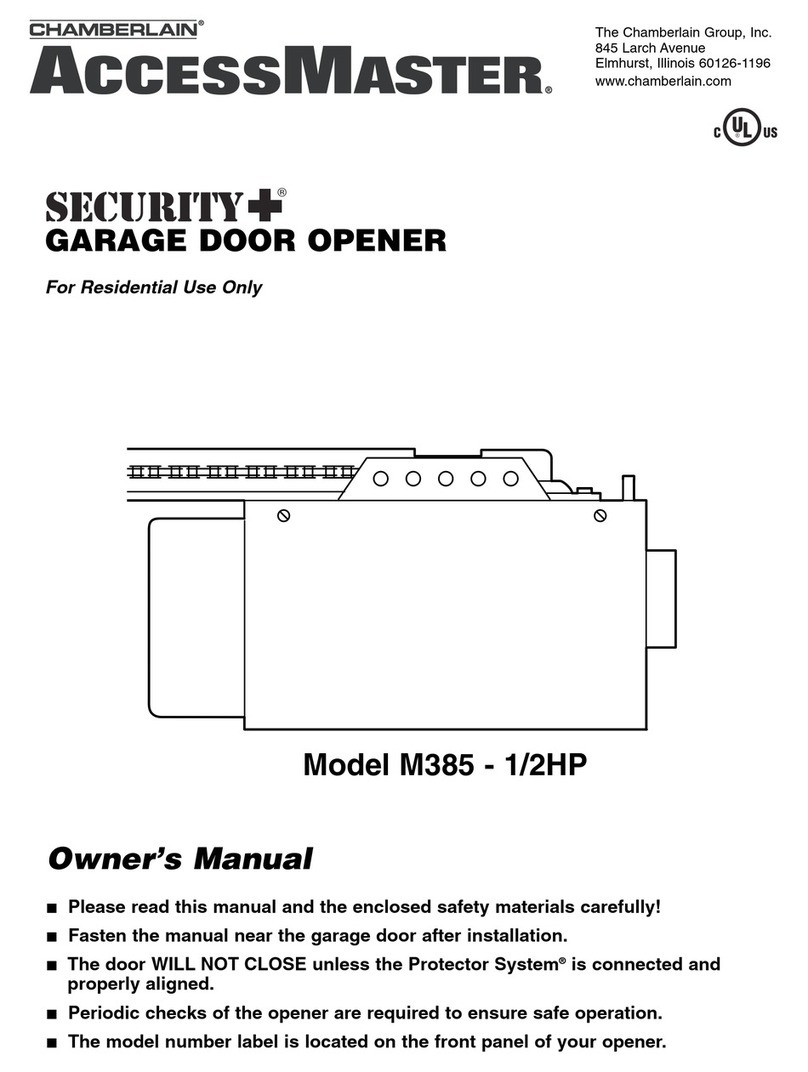
Chamberlain
Chamberlain Access Master Security+ M385 owner's manual
